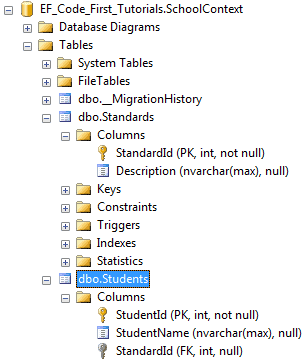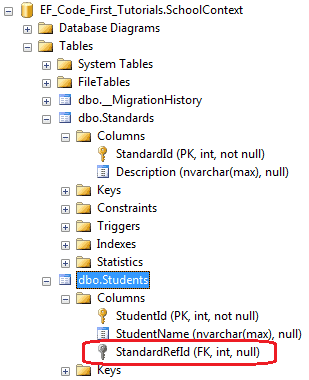Entity Framework Code-First(9.9):DataAnnotations - ForeignKey Attribute
DataAnnotations - ForeignKey Attribute:
ForeignKey attribute can be applied to properties of a class. Default Code-First convention for ForeignKey relationship expects foreign key property name match with primary key property.
Consider the following example.
public class Student
{
public Student()
{ }
public int StudentID { get; set; }
public string StudentName { get; set; } //Foreign key for Standard
public int StandardId { get; set; } public Standard Standard { get; set; }
} public class Standard
{
public Standard()
{ }
public int StandardId { get; set; }
public string StandardName { get; set; } public ICollection<Student> Students { get; set; } }
As you can see in the above code, Student class includes foreign key StandardId, which is key property in Standard class. So now, Code First will create StandardId column in Students class as shown below.

ForeignKey attribute overrides this convention. You can have a different name of a foreign key property name than the primary key of a dependent class.
public class Student
{
public Student()
{ }
public int StudentID { get; set; }
public string StudentName { get; set; } //Foreign key for Standard
public int StandardRefId { get; set; } [ForeignKey("StandardRefId")]
public Standard Standard { get; set; }
} public class Standard
{
public Standard()
{ }
public int StandardId { get; set; }
public string StandardName { get; set; } public ICollection<Student> Students { get; set; } }
As you can see in the above example, Student class includes StandardRefId foreign key property name instead of StandardId. We specify it using ForeignKey attribute on Standard navigation property so that Code-First will consider StandardRefId as foreign key, as shown below.

ForeignKey attribute can be applied to key property to specify which navigation property it points to, as shown below.
public class Student
{
public Student()
{ }
public int StudentID { get; set; }
public string StudentName { get; set; } //Foreign key for Standard [ForeignKey("Standard")]
public int StandardRefId { get; set; } public Standard Standard { get; set; }
} public class Standard
{
public Standard()
{ }
public int StandardId { get; set; }
public string StandardName { get; set; } public ICollection<Student> Students { get; set; } }
Thus, you can use ForeignKey attribute to give a different name to a foreign key property.
Entity Framework Code-First(9.9):DataAnnotations - ForeignKey Attribute的更多相关文章
- Entity Framework Code-First(9.6):DataAnnotations - StringLength Attribute
DataAnnotations - StringLength Attribute: StringLength attribute can be applied to a string type pro ...
- Entity Framework Code-First(9.5):DataAnnotations - MaxLength Attribute
DataAnnotations - MaxLength Attribute: MaxLength attribute can be applied to a string or array type ...
- Entity Framework Code-First(9.10):DataAnnotations - NotMapped Attribute
DataAnnotations - NotMapped Attribute: NotMapped attribute can be applied to properties of a class. ...
- Entity Framework Code-First(9.8):DataAnnotations - Column Attribute
DataAnnotations - Column Attribute: Column attribute can be applied to properties of a class. Defaul ...
- Entity Framework Code-First(9.7):DataAnnotations - Table Attribute
DataAnnotations - Table Attribute: Table attribute can be applied to a class. Default Code-First con ...
- Entity Framework Code-First(9.2):DataAnnotations - TimeStamp Attribute
DataAnnotations - TimeStamp Attribute: TimeStamp attribute can be applied to only one byte array pro ...
- Entity Framework Code-First(9.1):DataAnnotations - Key Attribute
DataAnnotations - Key Attribute: Key attribute can be applied to properties of a class. Default Code ...
- Entity Framework Code-First(9.4):DataAnnotations - Required Attribute
Required attribute can be applied to a property of a domain class. EF Code-First will create a NOT N ...
- Entity Framework Code-First(9.3):DataAnnotations - ConcurrencyCheck Attribute
ConcurrencyCheck Attribute: ConcurrencyCheck attribute can be applied to a property of a domain clas ...
随机推荐
- 第四章 python中的面向对象设计
一.首先来理解几个面向对象的关键特性: 1.封装:对象可以将他们的内部状态隐藏起来.python中所有特性都是公开可用的. 2.继承:一个类可以是一个或多个类的子类.python支持多重继承,使用时需 ...
- 吴恩达机器学习笔记(四) —— BP神经网络
主要内容: 一.模型简介 二.一些变量所代表的含义 三.代价函数 四.Forward Propagation 五.Back Propagation 六.算法流程 待解决问题: 视频中通过指出:当特征变 ...
- mac下搭建前端自动化工程
好多年没有接触前端,发现前端行业发生了巨大的变化,很多新鲜术语,比如node.git.grunt.less.sass.预编译.自动化.模块化等等,看得让人晕头转向,不要担心,我会把这之前之后学习成果都 ...
- Javascript- Javascript学习
Javasrcipt的引入方式 内部引入方式 直接将javascript代码写入到<script type="text/javascript"></script& ...
- jQuery-选择器(2)
jQuery选择器(2) 继续学习jquery选择器,感受它对于操作DOM节点的方便. [属性筛选选择器]属性选择器可以让你基于属性来定位一个元素.可以只指定该元素的某属性,这样所有使用该属性而不管它 ...
- 十二 Django框架,自定义分页
自定义分页模块 #!/usr/bin/env python #coding:utf-8 from django.utils.safestring import mark_safe #封装分页类模块 c ...
- python 特征选择 绘图 + mine
demo代码: # _*_coding:UTF-8_*_ import numpy as np import sys import pandas as pd from pandas import Se ...
- ES doc_values介绍2——本质是field value的列存储,做聚合分析用,ES默认开启,会占用存储空间
一.doc_values介绍 doc values是一个我们再三重复的重要话题了,你是否意识到一些东西呢? 搜索时,我们需要一个“词”到“文档”列表的映射 排序时,我们需要一个“文档”到“词“列表的映 ...
- Vue2.0 Transition常见用法全解惑
Vue2.0的过渡系统(transition)有了很大的改变,想把1.0的项目迁移到2.0,着实需要费一些功夫,今天我就要把vue2.0的过渡系统的用法搞清楚,因为之前确实踩了不少坑.这里只涉及单元素 ...
- struts2--标签取值
OGNL的概念: OGNL是Object-Graph Navigation Language的缩写,全称为对象图导航语言,是一种功能强大的表达式语言,它通过简单一致的语法,可以任意存取对象的属性或者调 ...
